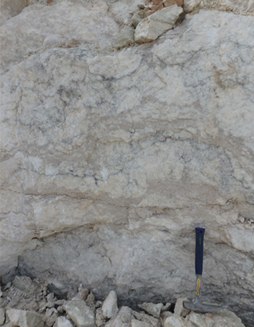Geoscience
Industrial Minerals
Commodity Summaries: Gypsum
| Introduction Production of gypsum in Manitoba commenced in 1901 and has continued until the present day. Gypsum is an evaporitic mineral (CaSO4•2H2O) and its dehydrated form is referred to as anhydrite. Gypsum and anhydrite are primarily formed from hypersaline bodies of water. Gypsum is found in economic quantities and purities from the Upper Amaranth Member of the Amaranth Formation in Manitoba. It is thought that the Upper Amaranth Member was formed up to 200 Ma ago but recent studies have questioned this interpretation. When the Upper Amaranth Member is located near surface, it is commonly composed of gypsum due to exposure to circulating groundwater. Deeper in the subsurface the member is composed primarily of anhydrite, as increasing pressure and temperatures underground lead to dehydration. Gypsum is a water soluble mineral, and in places the Upper Amaranth Member is prone to karsting and sinkhole development. Hundreds of caves have been identified in the Gypsumville area, and sinkhole development has been documented on the west side of Lake Manitoba, namely in the Harcus area, where gypsum occurs near surface. Applications Gypsum has many potential industrial uses. In Manitoba, gypsum was and is currently still used primarily for the production of wallboard. It is also used as an additive to cement. Other uses of gypsum include, but are not limited to: • Soil conditioner and fertilizer for agriculture; • Plaster; • Blackboard chalk; • Culinary applications, including as an additive to tofu, brewing, etc.; • Additive in personal care products; and • Pollutant removal from water. |
|
|
| Deposits and Occurrences Historically, gypsum has been mined in Manitoba from two different areas: underground mines were found in the town of Amaranth on the west side of Lake Manitoba, and in the Silver Plains region, south of Winnipeg. Currently, economic occurrences of gypsum are extracted from near surface and have been documented from two locations in the province. The known deposit from the Gypsumville area, north of Lake St. Martin, is an anomalous outlier of the Amaranth Formation. It is thought to have formed in an ancient depression that was caused by a meteor impact up to 300 Ma ago. This impact crater is referred to as the Lake St. Martin igneous and metamorphic complex. Although not active at present, this location was quarried for gypsum and there is still potential for extensive economic gypsum deposits in the area. The second known location of near surface gypsum is in the Harcus area, on the west side of Lake Manitoba. In this area, the Amaranth Formation is covered by a variably thick bed of Quaternary sediments, in places thin enough for the economic quarrying of gypsum. Suggested References Bannatyne, B.B. 1959: Gypsum-anhydrite deposits in Manitoba; Manitoba Mines and Natural Resources, Mines Branch, Publication 58-2, 46 p. Bannatyne, B.B. 1977: Gypsum in Manitoba; Manitoba Department of Mines, Resources and Environmental Management, Mineral Resources Division, Mineral Education Series, 77-1, 8 p. Gunter, W.R. 1987: Gypsum in Manitoba (revised); Manitoba Energy and Mines, Mineral Education Series 1987, 12 p. Lapenskie, K. and Bamburak, J.D. 2016: Gypsum investigations in the Harcus area, southwestern Manitoba (NTS 62J10): 2016 update; in Report of Activities 2016, Manitoba Growth, Enterprise and Trade, Manitoba Geological Survey, p. 181–186. |
||




